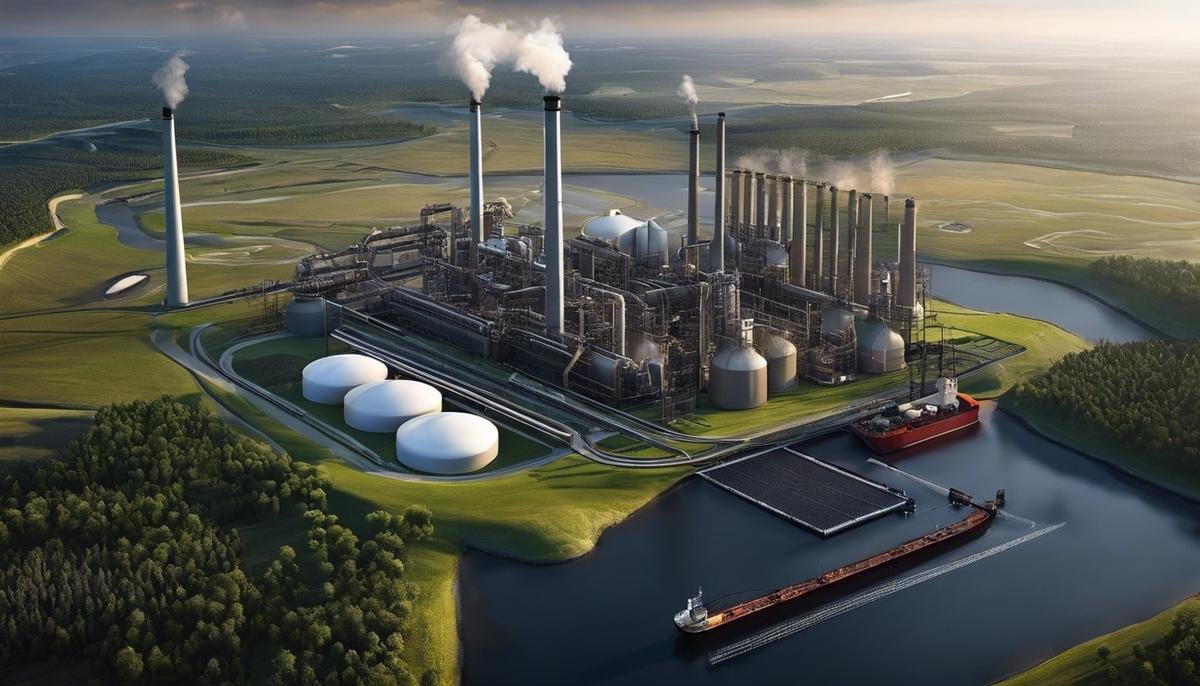As the world grapples with the escalating challenges of climate change, Artificial Intelligence (AI) stands at the forefront of the technological revolution, poised to transform our approach to this global issue. From advanced prediction models that decipher the complexities of our atmosphere, to the intelligent optimization of energy usage and the pioneering frontiers of carbon capture strategies, AI’s influence is widespread and dynamic. This exploration ventures into the intricacies of how AI not only enhances our understanding of climate dynamics but also pioneers the innovations and policies needed to steer our planet towards a more sustainable future. Through a tapestry of technological achievements and aspirations, we uncover the pivotal role AI plays in shaping our response to an ever-evolving climate landscape.
The Role of AI in Climate Prediction and Modeling
The Transformative Power of Artificial Intelligence in Climate Prediction and Modeling
The advent of Artificial Intelligence (AI) in the field of climate science marks a paradigm shift with profound implications for our understanding and prediction of Earth’s ever-varying climate system. Climate prediction and modeling, an endeavor that seeks to project future climate conditions based on current and historical data, is undergoing a significant transformation driven by AI’s potent capabilities.
At its core, climate modeling consists of constructing and utilizing sophisticated algorithms that simulate the physical processes of the atmosphere, oceans, and land surfaces. Traditional models, while immensely valuable, are constrained by computational limitations and the complexity of climate dynamics. AI, however, introduces methodologies that transcend these limitations.
One of the preeminent ways in which AI revolutionizes climate modeling is through the enhancement of computational efficiency. Deep learning algorithms, a subset of AI, are capable of processing vast datasets rapidly and with a high degree of accuracy. This velocity and precision enable researchers to refine climate models more swiftly, thereby accelerating the pace at which climate predictions are made and the granularity of the models themselves.
Furthermore, AI fosters improved treatment of uncertainty in climate predictions. Uncertainty is an intrinsic characteristic of climate modeling, arising from both model imperfections and the innate unpredictability of some climate processes. AI algorithms adeptly identify patterns within large datasets, many of which may elude human analysts or conventional computational methods. By discerning these complex patterns, AI can offer more nuanced interpretations of data, potentially reducing uncertainty and refining predictions.
Another transformative aspect of AI in climate science is its capacity to assimilate heterogeneous data sources. Climate data is not monolithic; it includes satellite observations, ground station measurements, ocean buoy data, and proxy records from tree rings and ice cores, to name a few. AI excels in synthesizing this disparate information, yielding comprehensive models that encompass the multifaceted nature of the climate system.
The ability of AI to experiment with novel modeling approaches also stands out. By leveraging techniques such as machine learning, AI can autonomously explore numerous potential climate scenarios and outcomes based on different data inputs and modeling strategies. This experimental liberty could unveil new insights into climate processes that have been hitherto inadequately understood or entirely overlooked.
The predictive prowess of AI is not without challenges, chief among them being the need for extensive, quality-controlled datasets and the interpretability of AI-powered models. Addressing these challenges requires meticulous data collection and the development of AI systems that are both powerful and comprehensible to scientists and policymakers.
In sum, AI is charting a new course for climate prediction and modeling, one that promises to enhance the accuracy and detail of climate projections. As the sophistication of AI technologies continues to advance, so too will our capacity to anticipate and prepare for future climate conditions. This progression is not simply an academic endeavor; it is critical to our sustained well-being on a planet whose climate is in uncharted territory.

Energy Efficiency and Resource Management through AI
Continuing from the previously articulated premises regarding the role of Artificial Intelligence (AI) in climate prediction and modeling, it is paramount to direct our attention to the explicit ways in which AI can further enhance energy efficiency and resource management.
AI’s ability to process vast amounts of data at unprecedented speeds allows for the precise optimization of energy systems. In the domain of energy efficiency, smart grids equipped with AI can dynamically adjust the flow of electricity to balance supply and demand, thus reducing waste and increasing the system’s reliability. This is achieved, in part, through advanced forecasting algorithms that predict energy consumption patterns, thereby enabling better planning and more efficient energy distribution.
Moreover, AI systems are adept at identifying inefficiencies in energy use within industrial processes and buildings. By analyzing operational data and continuously learning from it, these systems can suggest the most energy-efficient ways of operation, leading to tangible reductions in power usage and costs.
In the realm of resource management, AI shines in its ability to monitor and manage the consumption of natural resources. Precision agriculture, powered by AI, allows for real-time analysis of crop conditions, soil health, and water levels, ensuring that resources like water and fertilizers are distributed in optimal quantities. This minimizes waste and supports sustainable practices that are essential for the conservation of the earth’s finite resources.
Further application is seen in the management of water resources. AI algorithms can predict water demand and supply scenarios, provide insights for water conservation, and detect leaks and losses in water distribution systems. This reduces not only the water footprint of various sectors but also helps in the management of water-related disasters, contributing to more resilient communities in the face of extreme weather events due to climate change.
While there is great potential, it is crucial to ensure the ethical deployment of AI in resource management. For AI to be truly effective, the data it relies on must be accurate and the algorithms transparent and free from biases. This fosters trust and enables human experts to make informed decisions based on AI’s findings.
In conclusion, AI not only serves as a sophisticated tool to combat uncertainty and inefficiencies inherent in traditional climate and resource management strategies but also emerges as a cornerstone in the quest for sustainability. Through the meticulous and intelligent application of AI, there lies great promise for a more efficient and conscientious stewardship of our planet’s resources, thereby securing a more sustainable future for all.

AI-Driven Innovations in Carbon Capture and Storage
In exploring the myriad ways that artificial intelligence (AI) plays a pivotal role in climate change mitigation, one cannot overlook its burgeoning contribution to carbon capture and storage (CCS) technologies. Innovations in AI are poised to revolutionize this critical strategy, which is central to the containment of greenhouse gases and achieving global decarbonization goals.
AI-driven advancements in carbon capture technology include the optimization of absorption processes wherein AI systems forecast the most efficient use of solvents for capturing carbon dioxide (CO2) from industrial emissions. By analyzing vast data sets that encompass temperature, pressure, chemical composition, and other pivotal variables, these intelligent algorithms can precisely determine optimal operating conditions, thus enhancing the CO2 absorption rate, reducing solvent degradation, and lowering energy consumption.
Furthermore, the selection of suitable sites for carbon storage necessitates detailed geological analysis to ensure the permanence of storage and to prevent leakage. Through the application of machine learning, the identification of these geologically appropriate formations becomes not only more accurate but also rapid, by employing predictive models that assess the porosity, permeability, and integrity of subsurface structures. This predictive capacity contributes to safer and more reliable storage sites for sequestered CO2.
The role of AI in monitoring and verification is paramount to the credibility and effectiveness of CCS operations. Advanced sensor networks, combined with AI algorithms, enable real-time tracking of CO2 streams during transport and after injection into storage sites. Anomaly detection algorithms are critical in early warning systems for potential leaks or variations in the expected behavior of the stored CO2.
AI also undergirds advancements in the direct air capture (DAC) of carbon dioxide, facilitating the continuous improvement of chemical reactions and sorbent regeneration processes through the dynamic analysis of operational data. This ensures the economic feasibility and scalability of DAC technologies which are critical for the direct removal of CO2 from the atmosphere.
In addressing the integration of CCS within global energy systems, AI models assist in forecasting the demand for carbon credits and the economics of carbon markets. These intricate models support policy-makers and industry leaders in making informed decisions about investments in CCS infrastructure as well as framing regulatory frameworks that promote the utilization of CCS technologies.
Crucially, AI can optimize the entire lifecycle of CCS projects, from inception and planning through to operational efficiency and eventual decommissioning. AI augments the decision-making matrix with predictive analytics that evaluate numerous scenarios, their potential outcomes, and the associated risks, providing stakeholders with valuable insights for strategic planning.
The convergence of AI with carbon capture and storage strategies is an exuberant representation of technological synergy addressing one of the most pressing challenges of our time. The embrace of AI within CCS operations not only underscores a commitment to innovative problem-solving but also reflects a broader recognition of the urgency in deploying intelligent systems to safeguard our environment. The promise of AI in enhancing the efficiency and efficacy of carbon capture and storage is not merely a scientific pursuit but a collective step towards a sustainable and thriving planetary future.

AI in Climate Policy and Economic Implications
The Influence of Artificial Intelligence on Climate Policy Formulation and Economic Impacts
Climate policy formulation at its core demands an intersection of environmental science, economics, and societal values. The deployment of Artificial Intelligence (AI) as an instrumental technology in this space reveals various avenues through which it facilitates policy design and economic consequences.
AI-driven tools are revolutionizing the way policymakers access and interpret climatic and economic data, effectively providing a bridge between raw data and actionable policy. For instance, AI is instrumental in scanning vast amounts of social media data to gauge public opinion on environmental matters, thus enriching the democratic underpinnings of policy formulation. In such ways, AI becomes a harbinger of heightened societal engagement in climate policy discourse.
Moreover, economic sectors stand to be transformed as AI advances lead to the creation of new markets and industries, such as those centered on AI-enabled energy-efficient technologies and climate adaptation solutions. The growth of these markets underscores job creation and fosters economic resiliency. Concurrently, AI’s predictive capabilities extend to market analysis, allowing for nuanced understanding of climate policy impacts on diverse economic segments. Investors and businesses leveraging AI insights can thus make informed decisions aligned with sustainability and economic health.
Furthermore, AI applications can monitor and enforce policy compliance by tracking environmental regulations and identifying non-compliance swiftly. For instance, AI-powered satellites can detect illegal deforestation, while AI algorithms can ensure adherence to emissions trading systems. This heralds a future where transparent and effective climate governance is juxtaposed against AI’s vigilant eye.
AI also assists in balancing climate action with economic growth through technology such as climate-informed decision AI systems. These systems analyze potential economic outcomes of climate policies, enabling policymakers to steer a course that minimizes adverse economic impacts while remaining steadfast in environmental commitments. Accordingly, AI serves as an adjunct to policy wisdom, striking an equitable balance between the urgency of climate action and the pragmatism of economic sustainability.
It is, however, germane to approach AI integration with deliberate consideration of socio-economic disparities. Ensuring equitable access to AI benefits within climate policy is paramount to averting a dichotomy where only certain economies reap the technological and economic harvests. To this end, global collaborations on AI technology-sharing and capacity-building are as essential as the innovations themselves.
In the ultimate analysis, the contribution of AI to climate policy formulation and its economic impacts interlaces with the broader agenda of transitioning to a low-carbon, sustainable economy. The nexus between AI and climate policy is set against a grand tapestry where proactive, informed, and equitable policy holds the potential to safeguard economic vitality while endeavoring towards ecological balance. Thus, the evolution of AI stands not only as a testament to technological prowess but as a cornerstone for future-proofed policy-making in our collective pursuit of a harmonious coexistence with our planet.

AI for Climate Change Mitigation and Adaptation
Artificial Intelligence’s Influence on Renewable Energy Deployment and Management
Artificial intelligence has become a keystone in the strategic deployment and management of renewable energy sources. As nations rally to reduce their carbon footprint, AI stands as an instrumental ally in the identification, development, and integration of renewable energy systems. One salient application is in the enhancement of wind and solar energy production, where predictive analytics can markedly increase their efficiency and output.
Wind and solar energies are inherently variable in nature, but AI’s predictive capabilities enable accurate forecasting of energy generation by analyzing weather patterns, historical data, and sensor information. This precision allows for the seamless integration of renewables into the energy grid, maximizing output and reducing the dependence on fossil fuels.
Furthermore, AI optimizes the orientation and operation of solar panels and wind turbines to elicit maximal energy capture. Machine learning algorithms proactively adjust settings in real-time, responding to changing environmental conditions to ensure optimal performance.
Another notable application of AI is in energy storage systems, particularly batteries. AI monitors and manages the charge/discharge cycles, thereby augmenting the lifespan of batteries and enhancing the stability and reliability of renewable energy systems. Predictive maintenance, driven by AI, forecasts potential failures and recommends preventive actions, which results in lowered downtime and costs.
In electric vehicle (EV) proliferation, AI significantly shapes charging network infrastructure. By analyzing a multitude of variables such as traffic patterns, vehicle usage statistics, and grid capabilities, AI is central to the strategic placement and operation of EV charging stations. This facilitates a smoother transition to electric mobility, which is crucial for reducing transportation-related emissions.
Artificial Intelligence also revolutionizes the consumer’s role in energy systems through demand-side management. AI-driven systems empower consumers to participate actively in energy conservation. Smart home devices, for instance, use AI to automate energy-saving actions like adjusting thermostats or controlling lighting, based on user behavior and preferences.
Furthermore, AI engages in the dynamic pricing of electricity, which can sway consumer behavior to align with periods of high renewable energy generation. Such real-time pricing mechanisms encourage users to shift their energy usage to times when the grid is most flush with renewable energy, thereby easing the integration of these sources into our daily consumption patterns.
Lastly, AI plays a critical role in advancing renewable energy policymaking and regulatory frameworks. By simulating various policy outcomes and assessing the impact on renewable energy adoption, AI aids policymakers in crafting more effective regulations and incentives. These data-driven insights are crucial for accelerating the transition to a renewable-powered future.
The deployment of artificial intelligence in renewable energy systems and infrastructure is a testament to the symbiotic relationship between technology and environmental stewardship. AI’s advanced analytics and machine learning capabilities not only enhance the deployment and integration of renewable energy sources but also streamline their management and lay the foundation for a resilient, sustainable energy future. While the path to a fully renewable-powered society is complex and rife with challenges, AI serves as an indispensable tool in this global endeavor, propelling us toward an era of clean, renewable energy.

With the promise of AI lies a remarkable toolkit that offers humanity the chance to not only confront but also adapt to the myriad challenges posed by climate change. The depth of its integration in various sectors underscores a collective commitment to harnessing its potential for the greater good. As we stand at the crossroads of technological ingenuity and environmental stewardship, the coming years will undoubtedly reveal the extent to which AI can transform our climate crisis into an opportunity for innovation and resilience. Embracing AI’s advancements while remaining vigilant of its limitations and ethical considerations will be crucial as we navigate the complex terrain of climate action and strive for harmony with our changing world.



